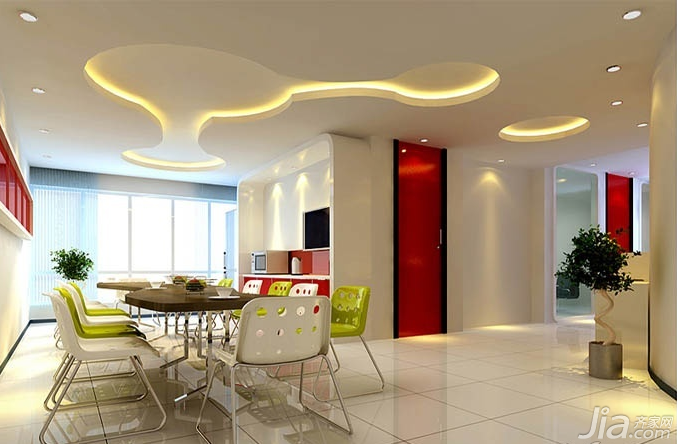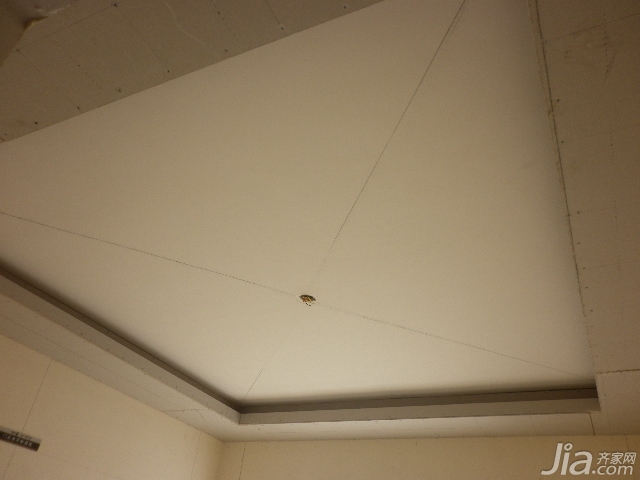The gypsum board ceiling is different from the aluminum buckle board ceiling and the pvc ceiling. The gypsum board ceiling has its own construction process. This article describes the construction process and construction conditions of the gypsum board ceiling. Understanding these can help everyone in the home ceiling construction. Learn it!

Plasterboard ceiling construction technology
When we chose the plasterboard as the ceiling material in the room, the general choice of keel is light steel keel and wood keel. Light steel keel, which is a profile made of sheet metal, it includes: expansion bolts, hanging bars, large cranes (large hanging), main keel, deputy keel, middle crane (middle hung), edge keel, and various specifications of joints, etc. . When installing gypsum board, self-tapping screws (dry wall nails) are also required; wooden keels are suspended ceilings, and the material is made of basically the same size wood.
During the construction of gypsum board ceilings in homes, each city has a decoration construction standard issued by the Decoration Association. You can go directly to the association for this question. In simple terms, the gypsum board main keel spacing is generally between 600 and 800, and vice keel spacing is within 600 according to the shape setting. Hangers are 8 mm diameter spiral ribs.

Light steel keel gypsum board ceiling construction process
First, the construction conditions
1, first according to the provisions of the design and construction drawings before the release of a main control line at the construction site.
2, the roof has been pressed according to the position of the keel
Second, the construction process
Construction sequence: Erection point location Line Erection Ceiling height line Drilling installation Hanger installation Main keel Installation T-type main keel and small bone Mechanical and electrical equipment Installation and acceptance Installation of gypsum board
1. According to the horizontal line of the room 50, design the elevation from the vertical vector to the suspended ceiling, the office is 2.6m (back to the line of 50 is 2.1m, the allowable deviation is ±3mm), and the corridor is 2.3m (back to the line of 50m back to 1.8m). The ceiling elevation line is horizontal, and the keel line is drawn on the wall. The suspension bar is 150mm from the wall. The distance between the main keel and the wall is not more than 150mm. The spacing between each keel is 1m, and 1m×1m squares are played under the floor slab. Grid line. Open large office hall arching 20mm, small office arch 5mm. Corridor, arching 2mm, the short span of the room arched.
2. After elevating the horizontal height of the ceiling elevation line and the position of the keel dividing line, determine the elevation of the lower end of the boom, and press the large keel position and the spacing between the booms to weld the end of the boom without a turnbuckle to the 40×40×4 corner. Use Φ8 expansion bolts to fix the ceiling.
3. The exposed length of the end thread of the suspender should not be less than 3mm. When installing the large keel, the big keel should be connected to the suspender by hanging pieces, and the screws should be fastened firmly. Large keel lengths can be connected using plug bodies. Large keels should be leveled after installation.
The main keel of 4, 38, and 50 should be arranged parallel to the direction of the lighting fixture. The boom should avoid the position of the tuyere and the lamp. Open-office smallpox requires 12 meters to weld the recumbent large keel to the upper part of the large keel to enhance the lateral stability of the large keel and the integrity of the boom.
5. After the middle keel has been installed, after checking that the elevation, spacing, straightness and hanging load meet the design requirements, the installation of the roof panel starts from the end of the keel in the middle row of the roof, and firstly installs a small keel of the side card, and then The Calcium Silicate Board rests on the flanges of the three sides of the keel, and then the other side of the small keel is installed. Branches are installed according to the above procedure. Finally, the T-shaped Ming keel is adjusted by pulling. After the professional procedures such as water, electricity and air conditioning are completed, ceilings can be installed.
6. The gypsum calcium silicate board should be trimmed perpendicular to the ribs on the back of the board when it needs to be trimmed. Lamps and air outlets should be adjusted so that the board is on the same horizontal line. Non-monolithic plates can be slotted with a plane so that one side of the cut can be lowered to keep it level. Corrosion must be applied to the nail holes after installation of the corridor gypsum board (brush antirust paint).
Tips: For more information about plasterboard ceiling, please pay attention to this site information.
More exciting recommendations:
Acceptance of plasterboard ceilings and metal ceilings
Gypsum board ceiling is expensive
What are the tips for purchasing gypsum board ceilings?
Gypsum board ceiling crack prevention
Hanging ceiling building materials knowledge living room ceiling room decoration home decoration paint ceiling price gypsum board ceiling price PVC ceiling price
We are China manufacturer of high quality grade 55, grade 105 Threaded Rods and threaded bars in astm f1554 standard. Our advantages and more services of threaded steel rods includes:
1) Wide range of diameters from 1/2" - 4"
2) Customized Length from 100mm to 12000mm
3) Good threads at 60 degree
4) Good straightness: 1mm/m max
5) Even hardness on whole bars
5) Proper mechanical properties
7) Full sets of testing equipment: Surface, Dimenstion. Mechanical properties testing
8) Fast delivery time
Grade 55 Threaded Rod,Astm F1554 Grade 105,Astm F1554 Threaded Rods,F1554 Grade 55 Threaded Rod
SHANDONG LE REN SPECIAL STEEL CO., LTD. , https://www.lerenspecialsteel.com